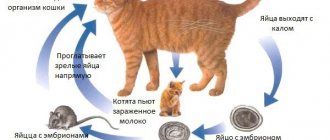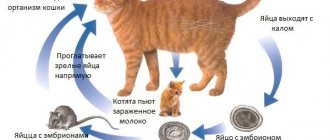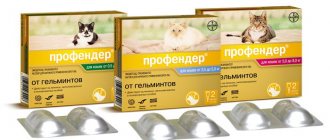The appearance of worms in cats is common, even in pets. It is difficult to completely eliminate parasite infection, because various factors can provoke the proliferation of parasites. In the article we will look at general and specific symptoms of infection, the first signs of the presence of helminths. We will also tell you how to independently identify worms in a cat.
The most common routes of infection:
- Thermally unprocessed foods, including raw meat, fish, unpurified water, chicken eggs;
- Insects, including fleas, flies, mosquitoes, through whose bites infection can spread;
- Contact with surfaces where eggs or worms are located. This could be shoes, garbage, etc.;
- Communication with other infected animals.
There are many ways of infection. It is quite difficult to identify them on your own; it is more important to notice in a timely manner that your pet has already become infected and you need to take measures to treat it.
Causes of worms in kittens
Important: absolutely all pets (even those that have never been outside) can encounter the problem of helminthiasis. This is due to the high vitality of parasites and their ability to move on all kinds of carriers. You can become infected with this disease in different ways:
- in utero from an infected mother;
- when eating fish or meat that has not undergone heat treatment;
- when drinking untreated tap water or well water;
- while communicating and playing with sick animals;
- through contact with the owner’s street clothes or shoes;
- through insects (fleas, lice, lice).
Worms will not appear in kittens that have strong immunity. As for weakened animals (pets under six months old, elderly animals, chronic cats), they have a risk of contracting the disease even through indirect contact with an infected object, not to mention living carriers of endoparasites.
Transmission to humans
Not all types of helminths are dangerous to humans. It is impossible to get infected with trematodes from a pet, but you can get infected with nematodes if hygiene rules are not followed.
For example, if you don’t wash your hands after interacting with a cat or cleaning its litter box.
An animal infected with cestodes is safe for the owner, but infection is possible through an intermediate carrier, for example, fleas.
Read more in the article about whether you can get worms from a cat.
How to understand that a kitten has worms. Symptoms of helminth infection
Signs of the presence of worms in kittens are determined by their type and location. Common manifestations of infection include:
- partial or complete loss of appetite;
- digestive disorders with signs of diarrhea and vomiting;
- changes in behavior (apathy, lethargy, nervousness);
- deterioration in appearance.
Remember: similar symptoms can occur with other diseases. Giving your pet deworming medication for kittens without laboratory confirmation of helminthiasis may worsen its condition.
In some cases, other signs of a pet being infected with helminths may appear. When they are localized in the gastrointestinal tract - thirst, abdominal pain, pallor of the mucous membranes. When worms settle in the liver and pancreas of a kitten, it faces health problems such as yellowness of the sclera, skin, and pain in the right hypochondrium. When helminths are localized in the animal’s heart, it develops shortness of breath, rapid heartbeat, wheezing, and coughing leading to vomiting. When endoparasites form their colonies in the lungs of kittens, the latter experience symptoms such as hemoptysis, wheezing in the chest, and increased body temperature.
Prevention
Since diagnosing helminthic infestations is difficult (even an infected animal may not have eggs in its feces, since helminths still do not reproduce 24 hours a day), veterinarians advise paying attention to prevention. To do this, you should maintain reasonable hygiene, clean the litter box on time, vacuum not only the carpets, but also the floor, and especially carefully in the area where the cat litter box is located, paying attention to the cracks where helminth eggs can get into. Do not feed your cat raw freshwater fish or meat from unreliable sources. Carry out preventive deworming regularly.
What worms can be found in a kitten?
Roundworms (nematodes). They are represented by roundworms, toxocaras, heartworms and hookworms. Depending on the type, they enter the body of a pet along with untreated meat, water, or through the bite of an infected insect. They are localized primarily in the gastrointestinal tract, but can affect the heart, lungs and other organs. They cause diseases that are difficult to treat and provoke the development of anemia in the pet, which is extremely dangerous for a fragile organism.
Tapeworms (cestodes). Represented by cucumber tapeworm, broad tapeworm, echinococcus and alveococcus. Depending on the species, they enter the pet’s body with raw fish, while swimming in the river or biting fleas that carry the parasite. They live exclusively in the intestines. They make themselves known by the manifestation of such signs of the presence of worms in a kitten, such as ulcers, tissue necrosis, perverted appetite, itching in the anal area.
Flatworms (flukes). Represented by cat fluke and pulmonary flukes. The animal is infected by eating raw fish and seafood. They parasitize the liver, gall bladder of a pet or its ducts. Feeding on animal tissues, damaging and destroying them, they lead to the formation of pulmonary paragonimiasis and alariasis. As a result of their impact on the body, serious pathologies of the respiratory system develop, which culminate in the death of the animal from pneumonia and sepsis.
Signs of parasites
External signs that help identify worms in a pet are quite varied, they depend on the location of the parasite. But there are general symptoms that help determine whether the baby has helminths:
- Lack of appetite.
- Losing weight.
- A kitten infected with worms develops and grows poorly; it lags behind its peers in parameters.
- Signs of intestinal distress: diarrhea, constipation, vomiting. If the baby vomits, then you need to check if he has worms.
- Bloating.
- There are signs of parasite infection such as purulent discharge from the eyes.
- Irritation of the anus, it can be understood if the baby fidgets on its tail on some rough surface.
- The most common symptoms are the external appearance of the pet being unkempt. The cat is kind of unkempt, unattractive, his fur is dull, with tufts.
- When the infestation is strong enough, the parasites can come out along with the feces.
Diagnostics
Having discovered the above symptoms, in order to begin proper treatment, you need to contact a veterinarian for diagnosis. He can determine the type of helminths, this is extremely necessary in order to prescribe effective treatment. A stool test collected in a special container will help determine whether there are helminths, and if so, what type is present in the cat’s body.
There are types of helminths that feed on the blood of cats. As a result, a fragile baby may develop anemia. If left untreated, it will be life-threatening for your pet.
Why is helminthic infestation dangerous?
Worms in kittens injure the mucous membrane of the digestive tract. Penetrating into the internal organs, they violate the structural integrity of the tissues and cells of the animal, limiting their functional activity. Emitting toxins during vital activity and decomposition, helminths lead to severe intoxication of the pet’s body. Weakened by the fight against endoparasites, the latter becomes vulnerable to various infections and viruses. In advanced cases (if vital arteries are damaged, the intestines are blocked or ruptured), the worst thing happens - the kitten dies.
Consequences and possible complications
By parasitizing the animal’s body, helminths cause significant harm to it, which can lead to dire consequences or complications:
old cat
- Mechanical damage. Worms attach to the intestinal walls and tissues of other organs, thereby compromising their integrity. In particular, by damaging the mucous membrane of the gastrointestinal tract, parasites cause minor necrosis and bleeding. A large accumulation of worms clogs the intestinal lumen, which can lead to its rupture and, consequently, the death of the pet.
- Metabolic disease.
- Toxic effects , causing poisoning of the body and allergic reactions. As a result of the vital activity of helminths, substances that are toxic to the host’s body are released. In addition, dead worms decompose. All this leads to significant poisoning of the animal.
- Trophic impact. Worms take some of the host’s vitamins, beneficial microelements and hormones, absorb blood, enzymes and digestive juice. As a result, your cat is constantly lacking essential nutrients.
- Decreased immunity. Through tissues damaged by worms, pathogenic microorganisms enter the blood of an infected cat, provoking inflammatory processes. As a result, various complications arise, since the body, weakened by parasites, is not able to fully resist infectious diseases.
Diagnosis of parasitic disease
It is easy to guess that a kitten has helminthiasis when the worms (or their larvae or eggs) come out along with its feces. In other cases, the manifestations of this disease can easily be confused with symptoms of a cold, indigestion, or diseases of the internal organs. What should I do? To make an accurate diagnosis, contact a veterinary clinic. There, the pet will be given a referral for OAC, a coprogram, and, if necessary, an ultrasound of the heart or liver and an X-ray examination of the lungs will be performed. Based on the results of tests for worms, the kitten will be prescribed treatment. Which one will depend on the type of disease detected.
Diagnostic features
Only a veterinarian can establish or refute the final diagnosis. During diagnosis, an analysis for enterobiasis is carried out; for this, feces or blood of the animal can be taken. If worm eggs are found in stool tests, the veterinarian will determine that the animal actually has parasites.
Interesting! Sometimes a kitten becomes infected with worms, but the mother's stool test for helminths may be negative. In this case, the parasites could enter the body through mother's milk.
At what age can a kitten be wormed?
The first deworming of a pet can be carried out at 3 – 6 weeks. The animal is dewormed again after 10 days. In the future, it is recommended to carry out antiparasitic treatment of the kitten at intervals of every 3–4 months. To select a drug for worms and calculate the correct dosage, it is recommended to consult a veterinarian. The specialist will examine the animal and give recommendations regarding the treatment of helminthiasis/prevention of its development.
Treatment for worms in kittens is mandatory before vaccination. The purpose of its implementation is to eliminate the negative impact of parasites on the animal’s body, reducing the risk of complications after immunization of the pet. This treatment is carried out 10 - 14 days before vaccination. It is believed that this time is enough for the kitten’s body to restore its immune status after suffering from parasitosis.
Despite the large selection of medicines, deworming is not carried out for everyone and not always. So, in particular, it is tolerated if the animal is weakened or in the acute stage of an infectious or chronic disease. A contraindication for treating a pet for worms is serious disturbances in the functioning of its liver and kidneys. The reason for medical withdrawal is individual intolerance to the components that are part of the anthelmintic drug.
Folk remedies
Folk remedies for worms in cats will also help rid your cat of worms. They are quite simple and affordable. The most effective include the following:
- A garlic enema will help remove worms from your cat at home. To prepare it you will need 6 cloves of garlic, which need to be cut into small pieces. Next, the garlic is poured into a glass of water and infused for two hours. Then you can give the animal an enema. However, with this method you need to be very careful, as a burn to the intestines is possible;
- fresh carrot enema. You need to squeeze about 20 ml of juice from the root vegetable and do an enema;
- a decoction of herbs - tansy flowers, peppermint, buckthorn bark, wormwood. You need to pour 2 large spoons of herbal mixture into a container and pour a glass of hot water. The prepared decoction must be given to the pet in the morning for three days.
What anti-worm medications for kittens should I choose?
Important: it is recommended to purchase and give your pet those medications that are appropriate for its age. The dosage should be selected depending on the degree of helminth infestation and their type. The drug should be given according to the instructions at the strictly designated time. Find out more from a specialist.
Suspensions
The medicine in this form is usually sold in syringes (without a needle), less often in bottles. Pre-shaken, it is poured into the animal’s cheek or mixed with a small amount of food. You do not need to select your own dosage.
Advantages: Worms in kittens are eliminated after a single use. It is convenient to give such an anthelmintic drug to an animal. The risk that the medicine will not give the desired effect is reduced to a minimum.
Disadvantages: Since the mucous membrane of kittens is sensitive, they may increase salivation and vomit. There is no need to be afraid of these manifestations. They disappear 15 minutes after oral administration of the drug.
Pills
Oral anthelmintics are given to the animal during the morning feeding. Method of administration: in powder form - along with food, in the form of a suspension (the powder is mixed with milk or water and poured into the kitten's mouth), in solid form under the tongue. The dosage is calculated according to the weight of the pet.
Advantages: Anti-worming tablets for kittens have a complex effect on the animal’s body. They have virtually no side effects. Some of these medications can be used to treat pets from 1 month of age.
Disadvantages: Some pets cough up the tablets within minutes of taking them. After compulsory treatment, they tend to be in a state of stress for a long time. During this period of time, the kittens do not leave their shelter and show serious resistance to any attempts to establish contact.
Drops on the withers
Medicines for external use. They are applied to the pet at the withers. Easily entering the bloodstream through the skin, such products begin to act throughout the body, not being inferior in effectiveness to suspensions and tablets.
Advantages: Anti-worm drops for kittens have a wide spectrum of action. They destroy not only internal, but also external parasites. Using such a medicine is simple - just apply it to the animal’s skin in places where it cannot lick it off.
Disadvantages: This type of drug has a weak effect. Most often it is used to prevent helminthiasis. After treatment, it is not recommended to wet the area where the anthelmintic was applied for 2 days.
Treatment
It depends on the type of helminth and is prescribed after consultation and examination. The veterinarian will prescribe treatment aimed not only at destroying the parasite, but also at its subsequent evacuation from the affected organs, preventing re-infection and restoring the animal’s body.
All drugs are divided into 2 types according to their spectrum of action, broad and narrow. The first type of medicine allows you to get rid of any helminths. These include:
- Prazicide is indicated for use in adults;
- Profender - prescribed from one month of age;
- Drontal – approved for use from the 21st day of a kitten’s life.
Narrow-spectrum drugs target one specific type of worm. Most often prescribed for:
- trematodes - Hexichol, Drontsit and others;
- nematodes - Nilverm, Naftamon, Ivomek, etc.;
- cestodes - Fenalidon, Fenasal, Lopatol, Bunamidin, etc.
It is extremely important to follow the dosage prescribed by the veterinarian, since if the medications are taken incorrectly, undesirable reactions may occur on the part of the cat’s body.
If treatment is inadequate, helminths will remain in the animal's body.
Read more in the article about medications for helminthiasis.











